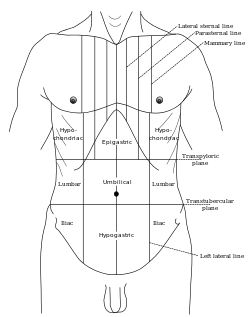Epigastrium
In anatomy, the epigastrium (or epigastric region) is the upper central region of the abdomen. It is located between the costal margins and the subcostal plane.
| Epigastrium | |
|---|---|
 Surface lines of the front of the thorax and abdomen | |
| Details | |
| Identifiers | |
| Latin | regio epigastrica |
| TA | A01.2.04.003 |
| FMA | 20389 |
| Anatomical terminology | |
The epigastrium is one of the nine regions of the abdomen, along with the right and left hypochondria, right and left lateral regions (lumbar areas or flanks), right and left inguinal regions (or fossae), and the umbilical and pubic regions.
During breathing the diaphragm contracts and flattens, displacing the viscera and producing an outward movement of the upper abdominal wall (epigastric region). It is a convergence of the diaphragm and the abdominals, so that "when both sets of muscles (diaphragm and abdominals) tense, the epigastrium pushes forward".[1] Therefore, the epigastric region is not a muscle nor is it an organ, but it is a zone of activity where the actions of the rectus abdominis and the diaphragm produce an outward bulging of the upper abdominal wall. It is also the spot where the Heimlich Maneuver is able to produce a rapid and forceful exhalation of breath.
Contents
References
- William Vennard, "Singing, the Mechanism and the Technique," 5th ed. (New York: Carl Fischer, 1968), 30.